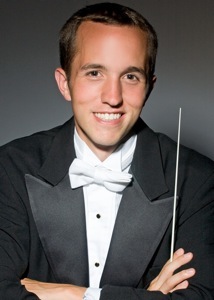A Closer Look at “Contemporary” Music
 When Christopher James Lees (pictured to the right), conductor of the University of Michigan Contemporary Directions Ensemble (CDE), challenged the literal meaning of “contemporary” before the group’s concert last Wednesday, he imbued the performance with special significance. The concert, dubbed “homage to the masters”, aimed to explore certain works’ and composers’ relevance, chronology notwithstanding, and featured Morton Feldman’s Madame Press Died Last Week at 90 (1970), Toru Takemitsu’s Air (1995), George Perle’s Six Celebratory Inventions (1995), Benjamin Lees’s Piano Trio no. 2 (1998) and Gyorgy Ligeti’s Chamber Concerto (1970) (additionally, Elliott Carter’s Gra (1975) was supposed to be played but the soloist was indisposed by illness).
When Christopher James Lees (pictured to the right), conductor of the University of Michigan Contemporary Directions Ensemble (CDE), challenged the literal meaning of “contemporary” before the group’s concert last Wednesday, he imbued the performance with special significance. The concert, dubbed “homage to the masters”, aimed to explore certain works’ and composers’ relevance, chronology notwithstanding, and featured Morton Feldman’s Madame Press Died Last Week at 90 (1970), Toru Takemitsu’s Air (1995), George Perle’s Six Celebratory Inventions (1995), Benjamin Lees’s Piano Trio no. 2 (1998) and Gyorgy Ligeti’s Chamber Concerto (1970) (additionally, Elliott Carter’s Gra (1975) was supposed to be played but the soloist was indisposed by illness).
I was surprised by the unwitting timeliness of Maestro Lees’ comments in relation to the faculty recital I attended the night before, a performance by Stephen Rush of a handful of works for piano and drum set. Rush is the director of the University of Michigan’s Digital Media Ensemble, and an acclaimed composer, jazz pianist and music author. Though he has worked with traditional genres, Rush’s music is decidedly unconventional and avant-garde, epitomized Tuesday night by a free-flowing mixture of improvised and composed-out materials. For this reason, I cannot tell you exactly what he played that night because the program was determined on the spot.
The music on both concerts was certainly modern, but which pieces were more contemporary? Pure chronology is a dangerous guide in this argument because “recent” and “contemporary” are not perfect synonyms. Rather, contemporariness springs from how an item or individual fits within the present, a distinction noted by Maestro Lees when he insisted that composers should not lose their cultural relevance once they die. The degree to which a piece of music represents the time in which is was written is hard to gauge in an era of music history without strict stylistic rigor. My opinion here is, of course, limited by my personal knowledge, but the most clearly outdated work between these two concerts was Ligeti’s Chamber Concerto. The work’s pervasive sound mass textures are representative of when it was written; further, the momentum of Ligeti’s musical development leaves little doubt that the Chamber Concerto is an ascending step along his career path, not its culmination.
More emblematic of art music’s recent history is the re-exploration of traditional harmonic structures and blending diverse influences. Benjamin Lees’ Piano Trio no. 2 “Silent Voices” (1998) best symbolized this trend among the pieces presented on Wednesday night’s concert. Like so many other living composers, Lees attempts to reinterpret functional tertian sonorities within a non-tonal landscape, but Lees, unfortunately, fails where so many others have succeeded. Piano Trio no. 2 is based on an arpeggio, but stalls shortly after this ideas is introduced. Lacking the sophisticated balance of order and chaos, tradition and progress we admire and herald in Schnittke, Rochberg, Rihm and many, many more, Piano Trio no. 2 is painfully ham-handed and seemed out of place along side the other works on the program.
In stark contrast, Stephen Rush’s compositions deftly combined a bounty of influences more diverse than one could anticipate. Ostensibly guided by his eccentricity, Rush’s performance Tuesday night included heaping servings of jazz and noise music, a duck-call rap solo, and multiple moments that smacked of Boulez and Webern, if they were to write or had written for piano and drum set. On account of these multifarious references, one could say Rush’s music captures the musically diverse period in which we live, but does eclecticism necessarily impart contemporariness? In the age of iPods and YoutTube, I am inclined to respond in the affirmative, but I am hesitant. On the surface, highly referential music would seem to be the best representative of the present cultural mélange, but it is more likely true that this varied musical landscape cannot be captured in a single musical snapshot.
In the end, these two concerts best represent contemporary music when seen together. While Steve Rush’s extemporaneous and heterogeneous creations signify the frontiers living composers explore with their music, one cannot hear his – or any other composer’s – works as isolated musical events. Rather, all contemporary music ramifies a singular tradition such that the green buds of art music’s future are intimately connected to the accomplishments of yesterday’s masters, regardless of how far musical style may stray from this central locus.
Maestro Christopher James Lees was certainly on to something Wednesday night when he exposed the misguidance behind labeling music “contemporary”. A piece of music relates to multiple time periods at once, and this connection fluctuates from note to note and piece to piece with the career on one composer, not to mention a whole generation. The wisdom behind the program for last Wednesday’s Contemporary Directions Ensemble concert lies in how it showcased modern music’s recent past, setting the stage for those works that form the youngest branch of music history. Combined with Stephen Rush’s recital, these concerts illustrate the importance of viewing music as part of the flow of music history and convincingly argue the problematics of describing music as “contemporary”.